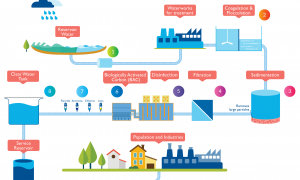🕑 Reading time: 1 minute
An open well is a cylindrical shaft made out of masonry in the ground with an uncovered opening. It is one of the most basic types of well that can be shallow or deep depending on the water table.
The open wells are constructed in such a manner that their depth is below the water table, thus allowing the groundwater to fill the bottom of the wells. The walls of such wells can be built out of precast concrete rings, stone, or brick masonry. The diameter of this well varies from 2 to 9 meters.
Contents:
1. Construction of Open Wells
From the construction point of view, the well can be classified into three types:
1.1 Type 1: Wells with Impervious Lining
These kinds of open wells have an impervious lining like masonry lining (resting on mota layer). They are the most stable and useful for exploiting water from beneath the surface.
- First and foremost a pit has to be excavated till the soft moist soil is reached. This can be done using hand tools. The pit’s diameter is to be slightly bigger than the well’s finished diameter.
- The kerb is to be laid at the bottom of the pit. A kerb is a circular ring of RCC, steel, or timber and has a cutting edge along with a flat top. It is wide and can support the thickness of the well lining called steining (or steening). The masonry lining has to be then built up to a few meters above the ground level on the kerb.
- The earth has to be excavated below the kerb. The kerb will then slowly sink as masonry is loaded on top of it.
- For ensuring vertical sinking, suspend plumb bobs around the well steining. In case the well starts sinking, adjust the load, or remove the soil underneath the kerb that is causing the tilt. Generally, the well lining is reinforced with vertical steel bars. Continue the process of excavation and sinking until the well reaches the water table.
- Further excavation can be done by removing water continuously or by using jhams. A jham is a self-closing bucket that is tied to a rope and can be moved up and down using a pulley.
- As the jham is thrown down into the well, the jaw strikes the bottom of the well and dislodges the soil. When the jham is pulled up, the water oozes out leaving the soil in the bucket.
- Continue sinking till you reach the mota layer. Puncture the confined aquifer below the layer by boring a small hole. In case the mota layer is unavailable, the shallow well can be sunk as mentioned in the previous steps up to a required depth. It can be filled with broken ballast or gravel. This will function as a filter by preventing the sand particles from entering the well.

In a pucca well having an impervious lining on its sides, the flow isn’t radial. Small weep holes can be made at the bottom of the lining to utilize the water present in topmost aquifer.
1.2 Type 2: Wells with Pervious Lining
In this type of wells, stones or dry bricks are used for lining the wall of the well. Here, binding materials or mortar is not used. The water seeps in through open joints and the sides as the linings are porous. Due to this, the flow is radial.
This type of well is plugged at the bottom by using concrete. If the bottom is not plugged, a mixed flow pattern combining radial flow and spherical flow will be seen.
It is better to construct this type of well where the soil strata are either made of coarse sand or gravel. In order to prevent sand from entering the well, the pervious lining must be surrounded by gravel or finer soils.
1.3 Type 3: Wells Without Lining (Kachha Well)
These types of wells are usually a temporary source of water. Cultivators construct this shallow depth well to supply water for irrigation in the fields.
The kachha well is generally constructed in hard soils so that the wall of the well can stand vertically without any support. It is very cheap and useful but could be a hazard to life as they can collapse easily after a certain period of time.
FAQs
An open well is a cylindrical shaft made out of masonry in the ground with an uncovered opening. It is one of the most basic types of well that can be shallow or deep depending on the depth of the water table.
The diameter of open well varies from 2 to 9 meters.
On the basis of construction, open wells are classified into wells having an impervious lining, pervious lining, and no lining.
Read More


